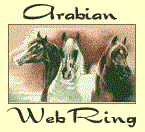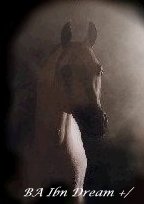| |
| |
"Nature, when she made the Arab, made no mistake."
During the Crimean War (1851 - 1854), one Arab horse raced 93 miles without harm, but its rider died from exhaustion.
Arabian
Homer Davenport

| |
| |
"Nature, when she made the Arab, made no mistake."
During the Crimean War (1851 - 1854), one Arab horse raced 93 miles without harm, but its rider died from exhaustion.
Arabian
Homer Davenport

The Arabian horse is arguably the most beautiful horse of all; it is unmistakable in character and appearance. It is also the purest and oldest of all breeds, having been carefully bred for thousands of years.
The Arabian's influence is apparent in the greater part of the world's equine population. It is acknowledged as the foundation of the Thoroughbred, which exceeds the Arabian in size and speed but cannot compare in terms of soundness and stamina.
While the exact origin of the Arabian is unclear, the evidence from art shows that a race of horses of fixed Arabian type was in existence on the Arabian Peninsula at least 2,500 years before the Christian era. The Bedouin, the people who were most intimately concerned with this "desert horse", trace their association, from around 3000B.C., to the mare Baz, and the stallion, Hoshaba. Baz is claimed to have been captured in the Yemen by Bax, the great-great grandson of Noah, tamer of the wild horses. The spread of the all-pervasive Arabian blood throughout the world was made possible by the Muslim conquests, which were initiated by the Prophet Mohammed in the seventh century when the green banners of Islam, and the desert horses, swept through Iberia into Christian Europe.

The modern Arabian excels naturally at endurance riding although it is outclassed in the other competitive disciplines. Nonetheless, it is bred in great numbers throughout the world with rare dedication, and is still a major upgrading influence on other breeds. Arabian stamina is legendary and there are numerous records of the breed's remarkable powers of endurance. In the nineteenth century, races were often held over long distances in the desert and could last for three days. The action of the Arabian is described as "floating", the horse moving as though on springs. This creature is fiery and courageous but also possesses an exceptionally gentle nature.
Reference: The Ultimate Horse Book; Elwyn Hartley Edwards; 1991







Reference picture of *Talal is courtesy of Cherry Hill Arabians
Head shot reference courtesy of Craberry Fold Arabians
 |
|
<
Prev
|
Random
|
Next
>
|

|
 |
White Arabian Click to view: Index Random Next 5 Next Want to join the ring? Click here for info. A very special thank you to Tim for the graphics used in this webring |

 The Arabian Horse Breeders & Exhibitors Web-Ring is owned by The White Arabian
The Arabian Horse Breeders & Exhibitors Web-Ring is owned by The White Arabian
|
|---|
| [Skip Prev] [Prev] [Next] [Skip Next] [Random] [Next 5] [List Sites] |
 |
This Time for Change site owned by White Arabian. [ Previous 5 Sites | Previous | Next | Next 5 Sites] [Random Site | List Sites] Want to join Time for Change? Graphic designed by Sheila Hardie |
